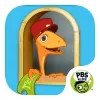Take a look inside 5 images
Dinosaur Train Classic in the Jurassic, Jr.!
Pros: Short segments of play and the overall theme and design are ideal for young players.
Cons: Limited levels of challenge means little depth to the learning experience.
Bottom Line: Builds on kids' interest in the hit series to develop mathematical thinking.
In a one-iPad classroom, teachers could use the games in Dinosaur Train Classic in the Jurassic, Jr.! to introduce the concepts of addition or ordering. Or they can use it as a station for kids to explore those concepts. In a 1:1 classroom, kids can use the mini-games for practice, but there's no assessment component. After students use this app, try the activities in the dino games -- weighing on a balancing scale or building a simple bridge out of blocks -- in the classroom and relate the hands-on work back to what kids learned in the digital games.
Dinosaur Train Classic in the Jurassic, Jr.! includes three fun games that require sorting, estimating, and pre-algebra skills. No reading skills are needed, and no login or account required. While there's not much connection with the television series Dinosaur Train beyond the characters and Jurassic setting, kids who enjoy the program will likely be excited to see the familiar characters. Kids need to help the dinosaurs in Troodon Town get ready for the Classic in the Jurassic, Jr. by building a bridge for the dinosaurs to cross, balancing food on a scale so the dinosaurs can chow down, and sorting dinosaurs by size to put them in the right houses. Kids drag their fingers across the space between two cliffs to find the number of logs they'll need for the bridge. They then use early algebra to figure out the right combination of logs to fit the space. To feed the dinosaurs, kids place food on a balance scale to make sure the dinosaurs get the right amount of food. When the scale is properly balanced, the dinosaur can eat. Kids arrange dinosaurs by size and then place them in the right houses. Then, kids can arrange a sticker scene that they can view online with a code. Most kids will complete the three games pretty quickly and may not want to return to it many times after that, since there's no variety or increasing difficulty levels.
This app isn't about counting or recognizing numbers like so many math apps geared for younger kids, but it gets kids thinking mathematically. It is non-reader friendly, with verbal instructions and multiple chances to get the right answer. There's no tracking or reporting of what skills kids are learning or in which parts of the games a kid may be having difficulty; adding some tracking and reporting would improve this app.












